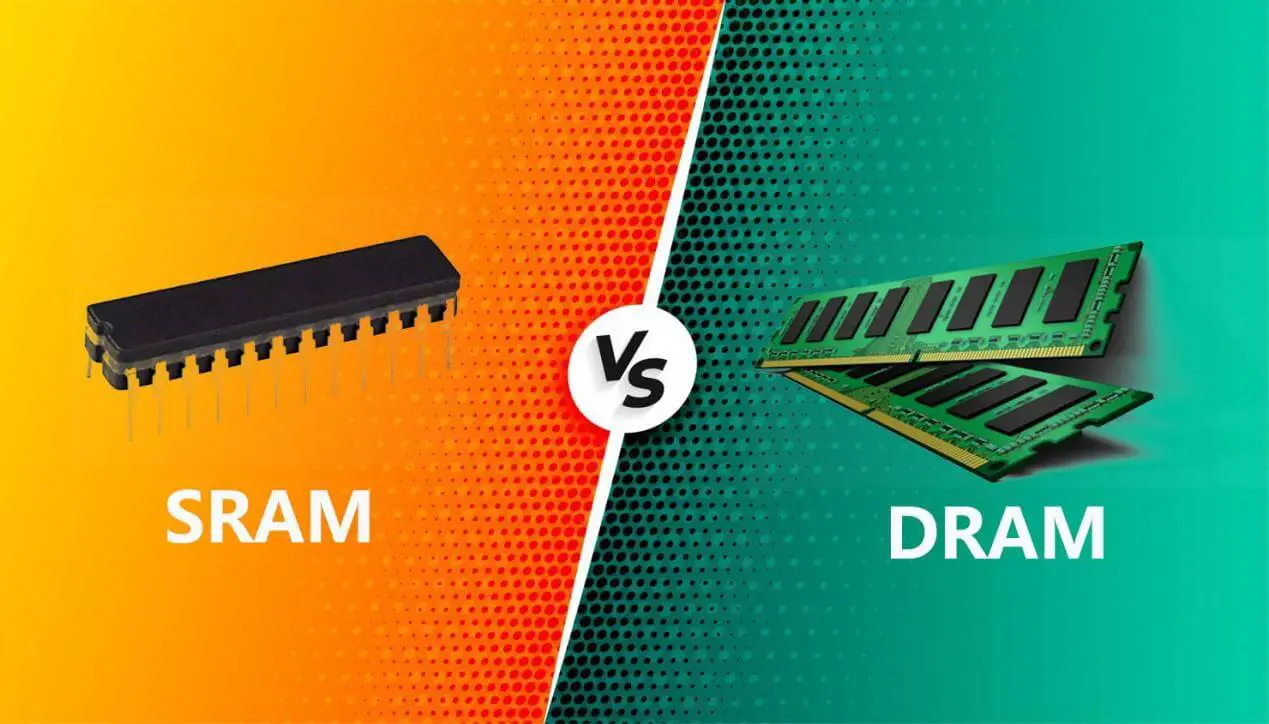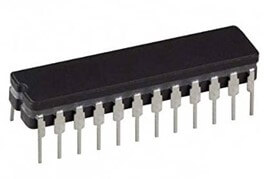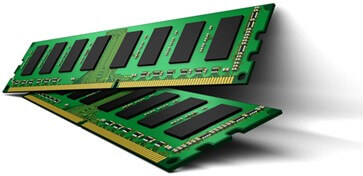Random-access memory (RAM) is of two main types: SRAM and DRAM. They might sound similar, but they do different jobs. Let’s dive into what makes them unique and how they impact the way your computer works!

What is SRAM?
Static random-access memory (SRAM) is a type of RAM. The term “static” refers to the fact that the data stored in it remains unchanged as long as the memory is powered on. On the other hand, data stored in Dynamic Random Access Memory (DRAM) requires frequent updates. Data stored in SRAM is referred to as volatile memory since it vanishes when the power supply fails, in contrast to ROM or flash memory, which may keep storing data even after a power loss. Because static memory is achieved using the same standard CMOS used for FPGA boards, this SRAM technology allows an infinite number of device reprogramming and has the best ratio of the device area for user resources to the area utilized by configuration memory.

As microelectronics technology develops swiftly, SRAM gradually follows the trend of high integration, speed, and low power consumption. With its many applications, static random access memory (SRAM) has become an essential and indispensable part of semiconductor memory development. In recent years, SRAM has positively impacted system performance, chip reliability, and cost reduction.
What is DRAM?
DRAM, or dynamic random access memory, is now the industry standard for memory. The primary electronic devices consist of a transistor and a capacitor with a charge representing “1” and no charge representing “0”. Because the capacitor’s charge gradually drains over time and needs to be “recharged” at regular intervals—hence the term “dynamic”—random access implies that the time required to read or rewrite any of these bits is the same. Because of random access, reading or writing any of these bits takes the same time. DRAM is now widely utilized because of its inexpensive cost, quick access speed, and simple design, which enable large-scale integration. Ersa Electronics will provide electronic devices like transistors, capacitors, and other components.

The channels, ranks, DRAM chips, banks, memory arrays, and memory cells make up the DRAM hierarchy. The memory cell is the most basic type of storage unit, with storage objects of 1 or 0. The bank is the smallest controlled unit. The number of channels corresponds to the number of memory sticks, and the rank is essentially comparable to a “memory stick” (a memory stick can contain several ranks).
How does an SRAM work?
When an SRAM cell is given a state of 0 or 1, it will remain in that condition until it receives a new state or until there is a power interruption, at which time it will change or vanish. An SRAM cell typically consists of 4-6 transistors.
SRAM is comparatively fast and power-efficient, but the cost of production goes up because it needs 4–6 transistors to store one bit of data. DRAM, on the other hand, requires one transistor to generate. The fundamental SRAM cell consists of two CMOS inverters with cross-connected inputs and outputs, where the output of one inverter is connected to the input of another and the input of another inverter to the input of the first. This allows the two inverters’ output states to be locked and saved, or it allows the state of a single bit to be stored. The footprint of a basic cell will typically decrease with the number of transistors therein. More bit storage can be manufactured on the chip since the cost of producing silicon wafers is relatively stable, meaning that as the size of the SRAM basic cell shrinks, so does the cost of each bit of storage. The relatively simple operation of SRAM is introduced via the write 0 and write 1 operations.
How does a DRAM work?
DRAM is made up of transistors and small capacitance-f capacitor storage cells. Each memory cell has a tiny etched transistor powered by a tiny capacitor and stored in reserve. The capacitor and a miniature rechargeable battery share several characteristics. It can be electrically charged to stand for a 1 or discharged for a 0. Because charged capacitors lose their charge when they are discharged, they need to be “refreshed” with new charges regularly.
The accompanying figure shows the fundamental design of a typical DRAM structure. A traditional DRAM divides its address lines into two groups, unlike SRAM, to reduce the number of input address pins and increase packaging efficiency. The typical DRAM structure can have fewer input address pins by employing multiple address mechanisms, but this results in more challenging clock control of the standard DRAM memory cell, which slows down performance. To meet the requirement for high-speed DRAM applications, separate address input pins are usually used to reduce the complexity of clock regulation and increase operating speed.
SRAM vs. DRAM Characteristics
SRAM Characteristics
- SRAM is faster than DRAM.
- Several times more expensive than DRAMs.
- In comparison to DRAMs, it takes up a lot more area.
- Less energy-intensive than DRAMs
- Cache usage at level 1 or level 2.
- Since there is no waiting period between accesses, cycle time is much lower than for DRAM.
- It’s commonly employed as a cache for memory.
- DRAM is far slower than static RAM.
- Compared to DRAM, static RAM has more storage.
- Static RAM operates with less power.
DRAM Characteristics
- Reasonably priced.
- Its data lifespan is constrained.
- Refreshing is required.
- Slower compared to SRAM.
- Higher usage of power.
- Compared to SRAM, dynamic RAM operates more slowly.
- SRAM is more expensive than dynamic RAM.
- Power consumption is considerable for dynamic RAM.
Advantages and Disadvantages of SRAM and DRAM
Advantages of SRAM:
- Latches memorize data. Thus, there’s no need to set up separate circuits for regular refreshes.
- Quick access times since SRAM is constructed utilizing CPU-compatible semiconductor technology.
Disadvantages SRAM:
- All of the components are less integrated and more numerous than in DRAMs.
- Increased use of power.
- Larger in size and more costly to produce than DRAM.
Advantages of DRAM:
- The peripheral circuit is more complex and needs to be refreshed more frequently.
- Because they cannot write or read, refreshing gadgets are limited in how effectively they may employ their time.
Disadvantages of DRAM:
- Centralized refresh: All storage units are combined for a predefined refresh cycle, during which reading and writing operations must stop to refresh the system gradually.
- Decentralized refresh: At the end of each storage cycle, a distributed refresh is performed on each row of storage units.
- Asynchronous refresh is a hybrid of centralized and decentralized refresh.
SRAM vs. DRAM
| SRAM | DRAM |
| SRAM is used in high-performance applications. | Slower main memory is a component of DRAM. |
| SRAM-based high-speed cache memory. | Slower main memory is a component of DRAM. |
| SRAM stores data for as long as power is supplied. | Information is stored in DRAM for a short while after power is removed or as long as electricity is available. |
| Transistors are used in SRAM to store data. | Capacitors are used in DRAM to store data. |
| SRAMs are more radiation-resistant than DRAMs. | DRAMs are less radiation-resistant than SRAMs. |
| Since no capacitors are used, there is no need for refreshing. | The capacitor’s contents need to be changed frequently to keep data for a more extended period of time. |
| Both heat production and power consumption decrease. | Both heat production and power consumption increase. |
| This stores bits in the form of voltage. | This stores the bits using electric energy. |
| Devices with low density include SRAMs. | DRAMs are devices with a high density. |
Conclusion
Two forms of volatile memory frequently found in electronic devices are SRAM (Static Random-Access Memory) and DRAM (Dynamic Random-Access Memory). Each has advantages and characteristics of its own. Their internal architectures are one of the main distinctions between SRAM and DRAM. Flip-flops, used in SRAM to store data, need a steady power source to preserve the data they contain. DRAM, on the other hand, stores data on capacitors, which need to be periodically refreshed to keep the data from being lost. This basic distinction affects the performance and application of storage technologies in several ways.
SRAM and DRAM differ primarily in their speed. Because it doesn’t require refreshing cycles and has a simpler access mechanism than DRAM, SRAM is typically faster than DRAM. Because of this, SRAM is a good fit for applications like processor caches and high-speed memory buffers in networking equipment that need quick access to data. Their cost and density represent another significant distinction.
DRAM is generally less expensive to produce and more dense than SRAM. Because of this, DRAM is better suited for applications like primary system memory in computers and other devices that need a lot of memory. SRAM, on the other hand, is better suited for compact, high-performance memory applications where speed is crucial due to its lower density and higher cost.
To sum up, SRAM and DRAM are two different kinds of volatile memory, each having unique properties. While DRAM provides higher density and cheaper cost, making it more appropriate for applications that demand bigger memory capacity, SRAM allows faster access to data and is well-suited for high-performance applications. The system’s unique requirements and the trade-offs between cost, density, and speed will determine which type of memory to use: SRAM or DRAM.
